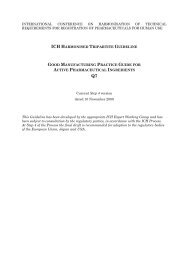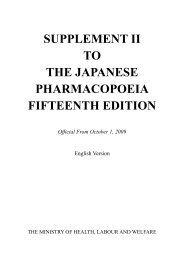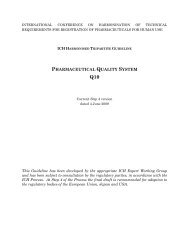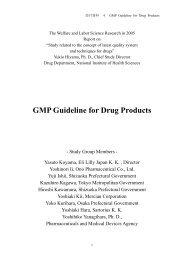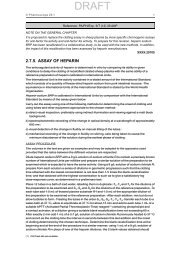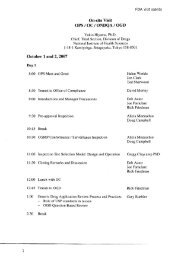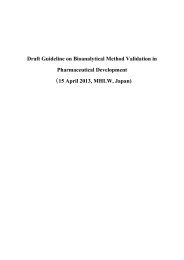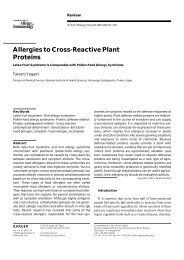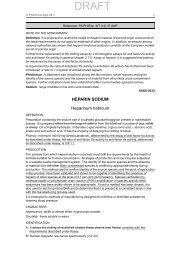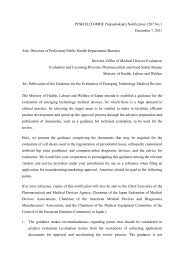Supplement I to the Japanese Pharmacopoeia Fourteenth Edition
Supplement I to the Japanese Pharmacopoeia Fourteenth Edition
Supplement I to the Japanese Pharmacopoeia Fourteenth Edition
Create successful ePaper yourself
Turn your PDF publications into a flip-book with our unique Google optimized e-Paper software.
1366 General Tests, Processes and Apparatus<br />
<strong>Supplement</strong> I, JP XIV<br />
Change <strong>the</strong> following:<br />
Arecoline hydrobromide for thin-layer chroma<strong>to</strong>graphy<br />
C 8 H 13 NO 2 .HBr White crystals. Freely soluble in water,<br />
soluble in methanol, and practically insoluble in diethyl<br />
e<strong>the</strong>r.<br />
Melting point: 169–1719C<br />
Purity Related substances—Dissolve 50 mg of arecoline<br />
hydrobromide for thin-layer chroma<strong>to</strong>graphy in exactly 10<br />
mL of methanol. Perform <strong>the</strong> test with 10 mL of this solution<br />
as directed in <strong>the</strong> Identiˆcation under Areca: any spot o<strong>the</strong>r<br />
than <strong>the</strong> principal spot at <strong>the</strong> Rf value of about 0.4 does not<br />
appear.<br />
N-Demethylroxithromycin C 40 H 74 N 2 O 15 White powder.<br />
Identiˆcation—Determine <strong>the</strong> infrared absorption spectrum<br />
of a solution of <strong>the</strong> substance <strong>to</strong> be tested in chloroform<br />
(1 in 20) as directed in <strong>the</strong> solution method under <strong>the</strong><br />
Infrared Spectropho<strong>to</strong>metry using a 0.1-mm cell made of<br />
potassium bromide: it exhibits absorption at <strong>the</strong> wave numbers<br />
of about 3600 cm -1 , 3520 cm -1 ,3450cm -1 , 3340 cm -1 ,<br />
1730 cm -1 and 1627 cm -1 .<br />
Geniposide for thin-layer chroma<strong>to</strong>graphy C 17 H 24 O 10<br />
White crystals or crystalline powder. Melting point: 159 –<br />
1639C.<br />
Purity Related substances—Dissolve 1.0 mg of geniposide<br />
for thin-layer chroma<strong>to</strong>graphy in exactly 1 mL of<br />
methanol, and perform <strong>the</strong> test with 20 mLofthissolutionas<br />
directed in <strong>the</strong> Identiˆcation (2) under Gardenia Fruit: any<br />
spot o<strong>the</strong>r than <strong>the</strong> principal spot at <strong>the</strong> Rf value of about<br />
0.3 does not appear.<br />
Imidazole TS Dissolve 8.25 g of imidazole in 65 mL of<br />
water, adjust <strong>the</strong> pH <strong>to</strong> 6.8 with 5 mol/L hydrochloric acid<br />
TS, and add water <strong>to</strong> make 100 mL.<br />
Add <strong>the</strong> following:<br />
2-Acetamidoglutarimide C 7 H 10 N 2 O 3 : 170.17<br />
Identiˆcation—Determine <strong>the</strong> infrared absorption spectrum<br />
of 2-acetamidoglutarimide as directed in <strong>the</strong> potassium<br />
bromide disk method under <strong>the</strong> Infrared Spectropho<strong>to</strong>metry:<br />
it exhibits absorption at <strong>the</strong> wave numbers of about 3350<br />
cm -1 , 1707 cm -1 , 1639 cm -1 and 1545 cm -1 .<br />
Purity Related substances—Dissolve 10 mg of 2-<br />
acetamidoglutarimide in 100 mL of <strong>the</strong> mobile phase, and<br />
use this solution as <strong>the</strong> sample solution. Pipet 1 mL of <strong>the</strong><br />
sample solution, add <strong>the</strong> mobile phase <strong>to</strong> make exactly 100<br />
mL, and use this solution as <strong>the</strong> standard solution. Proceed<br />
with 20 mL each of <strong>the</strong> sample solution and <strong>the</strong> standard solution<br />
as directed in <strong>the</strong> Purity (3) under Aceglutamide Aluminum:<br />
<strong>the</strong> <strong>to</strong>tal of <strong>the</strong> peak areas o<strong>the</strong>r than 2-<br />
acetamidoglutarimide from <strong>the</strong> sample solution is not more<br />
than <strong>the</strong> peak area from <strong>the</strong> standard solution.<br />
Content: not less than 98.0z. Assay—Weigh accurately<br />
about 20 mg of 2-acetamidoglutarimide, and perform <strong>the</strong><br />
test as directed under <strong>the</strong> Nitrogen Determination.<br />
Each mL of 0.01 mol/L sulfuric acid VS<br />
= 0.8509 mg of C 7 H 10 N 2 O 3<br />
Acetaminophen C 8 H 9 NO 2 [Same as <strong>the</strong> namesake<br />
monograph]<br />
Acetate buŠer solution, pH 5.4 To 5.78 mL of acetic<br />
acid (100) add water <strong>to</strong> make 1000 mL (solution A). Dissolve<br />
8.2 g of anhydrous sodium acetate in water <strong>to</strong> make 1000<br />
mL (solution B). Mix 176 mL of <strong>the</strong> solution A and 824 mL<br />
of <strong>the</strong> solution B, and adjust, if necessary, <strong>the</strong> pH <strong>to</strong> 5.4<br />
with <strong>the</strong> solution A or <strong>the</strong> solution B.<br />
0.02 mol/L Acetic acid-sodium acetate TS Dissolve 2.74<br />
g of sodium acetate trihydrate in a suitable amount of water,<br />
and add 2 mL of acetic acid (100) and water <strong>to</strong> make 1000<br />
mL.<br />
Albi‰orin C 23 H 28 O 11 .x H 2 O Colorless powder having<br />
no odor. Freely soluble in water and in methanol, and practically<br />
insoluble in diethyl e<strong>the</strong>r.<br />
Purity—Dissolve 1 mg in diluted methanol (1 in 2) <strong>to</strong><br />
make 10 mL, and use this solution as <strong>the</strong> sample solution.<br />
Perform <strong>the</strong> test with 10 mL of <strong>the</strong> sample solution as directed<br />
in <strong>the</strong> Assay under Peony Root; <strong>the</strong> <strong>to</strong>tal area of <strong>the</strong><br />
peaks o<strong>the</strong>r than albi‰orin and o<strong>the</strong>r than <strong>the</strong> solvent is not<br />
larger than 1/10 of <strong>the</strong> <strong>to</strong>tal area of <strong>the</strong> peaks o<strong>the</strong>r than <strong>the</strong><br />
solvent peak.<br />
0.05 mol/L Ammonium formate buŠer solution, pH 4.0<br />
Dissolve 3.5 g of ammonium formate in about 750 mL of<br />
water, adjust <strong>the</strong> pH <strong>to</strong> 4.0 with formic acid, and add water<br />
<strong>to</strong> make 1000 mL.<br />
Amoxicillin C 16 H 19 N 3 O 5 S.3H 2 O [Same as <strong>the</strong> namesake<br />
monograph]<br />
a-Apooxytetracycline C 22 H 22 N 2 O 8 Yellow-brown <strong>to</strong><br />
green powder.<br />
Melting point: 200–2059C<br />
b-Apooxytetracycline C 22 H 22 N 2 O 8 Yellow-brown <strong>to</strong><br />
brown powder.<br />
Purity Related substances—Dissolve 8 mg of b-apooxytetracycline<br />
in 5 mL of 0.01 mol/L sodium hydroxide TS,<br />
add 0.01 mol/L hydrochloric acid TS <strong>to</strong> make 100 mL, and<br />
use this solution as <strong>the</strong> sample solution. Proceed <strong>the</strong> test<br />
with 20 mL of <strong>the</strong> sample solution as directed in <strong>the</strong> Purity<br />
(2) under Oxytetracycline Hydrochloride, determine each<br />
peak area by <strong>the</strong> au<strong>to</strong>matic integration method, and calculate<br />
<strong>the</strong> amounts of <strong>the</strong>m by <strong>the</strong> area percentage method: <strong>the</strong><br />
<strong>to</strong>tal amount of <strong>the</strong> peaks o<strong>the</strong>r than β-apooxytetracycline<br />
is not more than 10z.<br />
L-Arabinose C 5 H 10 O 5 [K 8054: 1991, L(+)-Arabinose,<br />
Special class]<br />
Aris<strong>to</strong>lochic acid I for crude drugs purity test<br />
C 17 H 11 NO 7 Yellow crystalline powder. Melting point:<br />
about 2809C (with decomposition).<br />
Absorbance E 1z<br />
1cm (318 nm): 384 – 424 (1 mg, methanol,<br />
100 mL).<br />
Purity Related substances—Dissolve 1.0 mg of aris<strong>to</strong>-



